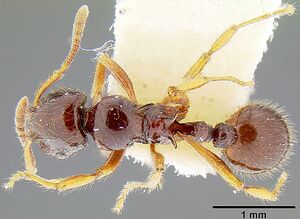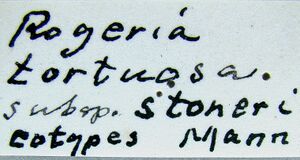Lordomyrma stoneri
| Lordomyrma stoneri | |
|---|---|

| |
| Scientific classification | |
| Kingdom: | Animalia |
| Phylum: | Arthropoda |
| Class: | Insecta |
| Order: | Hymenoptera |
| Family: | Formicidae |
| Subfamily: | Myrmicinae |
| Tribe: | Crematogastrini |
| Genus: | Lordomyrma |
| Species: | L. stoneri |
| Binomial name | |
| Lordomyrma stoneri (Mann, 1925) | |
Lordomyrma stoneri appears to be constricted to a narrow range of mountains in southeastern Viti Levu, close to Suva. Little is known about the biology of this species, but it has been collected by litter sifting. (Sarnat 2016)
Identification
Sarnat (2016) - One of the larger species of Lordomyrma in Fiji, L. stoneri has an attractive and shining reddish brown integument and strong, upturned spines. The species lacks a carinate anterior margin on the dorsal face of its propodeum and all examined specimens possess a robustly produced promesonotum that bulges above the level of its head and propodeum. Of the other three Fijian species that possess these characters, L. stoneri can be distinguished from Lordomyrma tortuosa by its weaker face sculpture, and from Lordomyrma desupra and Lordomyrma vuda by its strongly upturned propodeal spines. The only other species that has strongly upturned spines is Lordomyrma curvata, which is almost half the size of L. stoneri, has a strongly carinate anterior margin of the dorsal face of its propodeum, and has a strong rugoreticulum on the posterolateral corners of its head.
Keys including this Species
Distribution
Latitudinal Distribution Pattern
Latitudinal Range: -17.8° to -18.05083333°.
| North Temperate |
North Subtropical |
Tropical | South Subtropical |
South Temperate |
- Source: AntMaps
Distribution based on Regional Taxon Lists
Indo-Australian Region: Fiji (type locality).
Distribution based on AntMaps
Distribution based on AntWeb specimens
Check data from AntWeb
Countries Occupied
| Number of countries occupied by this species based on AntWiki Regional Taxon Lists. In general, fewer countries occupied indicates a narrower range, while more countries indicates a more widespread species. |

|
Estimated Abundance
| Relative abundance based on number of AntMaps records per species (this species within the purple bar). Fewer records (to the left) indicates a less abundant/encountered species while more records (to the right) indicates more abundant/encountered species. |

|
Biology
Castes
Worker
Images from AntWeb
    
| |
| Syntype of Lordomyrma stoneri. Worker. Specimen code casent0171014. Photographer Eli M. Sarnat, uploaded by California Academy of Sciences. | Owned by USNM, Washington, DC, USA. |
Nomenclature
The following information is derived from Barry Bolton's Online Catalogue of the Ants of the World.
- stoneri. Rogeria (Irogera) tortuosa subsp. stoneri Mann, 1925b: 5 (w.) FIJI IS. Combination in Lordomyrma: Kugler, C. 1994: 26. Raised to species: Sarnat, 2006: 25.
Unless otherwise noted the text for the remainder of this section is reported from the publication that includes the original description.
Description
Worker
Sarnat (2016) - TL 4.21–5.52, HL 0.95–1.00, HW 0.82–0.89, CI 0.85–0.87, SI 0.72–0.76, REL 0.18–0.24, PSLI 0.96–1.11, MFLI 0.91–1.07, DPWI 1.00–1.07 (8 measured).
A large shiny reddish brown species with a massive promesonotum, strong upcurved spines, and reduced sculpturing on face and body. In full face view, posterior margin of head evenly convex with rounded corners. Clypeus bearing one pair of weak carinae. Frontal carinae weakly carinate, terminating just after posterior level of eye. Antennal scrobe weakly impressed. Eyes of moderate size. In profile promesonotum massive, strongly convex, and bulging above the head and propodeum. Propodeal spines strong, triangular, divergent, and roughly as long as width of procoxae in profile when measured from, propodeal spiracle. Propodeal lobes of moderate size, triangular, stout. Petiole robustly built; anterior face strongly sloped and weakly concave; dorsal face more gently sloping and weakly convex; the rounded apex occurring at the anterior angle of node. Postpetiole with anterior and dorsal faces both evenly convex, apex occurring at midline. Mandibles smooth and shining with sparse, setigerous foveolae. Middorsum of head smooth and shining with scattered setigerous foveolae; several carinae mesad of frontal carinae; terminating just after posterior level of eyes. Frontal lobes with two pair of strong carinae in addition to the frontal carinae. In oblique lateral view, widely separated and weakly produced arcuate carinae above and below eye, mostly smooth and shining behind and in front of eyes. Promesonotum smooth and shining with scattered piligerous foveolae. Sides of mesonotum, metapleuron and propodeum overlain by coarse, widely spaced and occasionally intersecting rugae. In dorsal view, propodeum smooth and shining, without a transverse carina posterior to the metanotal groove; declivitous face smooth and shining. Petiole with smooth and shining anterior face, banded by coarse transverse rugae that cross the ventral face. Postpetiole coarsely rugoreticulate. Gaster smooth and shining. All shining surfaces laced with a delicate network of light etchings. All dorsal surfaces with an abundance of suberect to erect acuminate yellowish hairs, the longest of which equal or exceed the longest diameter of the eye. Head and mesosoma reddish brown, gaster and appendages lighter.
Type Material
Sarnat (2016) - Syntype, worker, Tamavua, Fiji (W.M. Mann) (National Museum of Natural History) (examined).
References
- Kugler, C. 1994. A revision of the ant genus Rogeria with description of the sting apparatus (Hymenoptera: Formicidae). Journal of Hymenoptera Research. 3:17-89.
- Liu, X., Xu. Z., Hita Garcia, F. 2021. Taxonomic review of the ant genus Lordomyrma Emery, 1897 (Hymenoptera, Formicidae) from China, with description of two new species and an identification key to the known species of the world. Asian Myrmecology 14: e014007 (doi:10.20362/am.014007).
- Mann, W. M. 1925. Ants collected by the University of Iowa Fiji-New Zealand Expedition. Studies in Natural History, Iowa University. 11(4):5-6.
- Sarnat, E. M. 2006. Lordomyrma (Hymenoptera: Formicidae) of the Fiji Islands. In N. L. Evenhuis and D. J. Bickel, editors. Fiji Arthropods VI, Bishop Museum Occasional Papers. 90:9-42. Bishop Museum, Honolulu, Hawaii.
References based on Global Ant Biodiversity Informatics
- Dlussky G.M. 1994. Zoogeography of southwestern Oceania. Zhivotnoe naselenie ostrovov Iugo-Zapadnoi Okeanii ekologo-geograficheskie issledovanii 48-93.
- Lucky A., and E. M. Sarnat. 2008. New species of Lordomyrma (Hymenoptera: Formicidae) from Southeast Asia and Fiji. Zootaxa 1681: 37-46.
- Sarnat Eli M. 2009. The Ants [Hymenoptera: Formicdiae] of Fiji: Systematics, Biogeography and Conservation of an Island Arc Fauna. 80-252
- Sarnat, Eli M. 2006. Lordomyrma (Hymenoptera: Formicidae) of the Fiji Islands. Fiji Arthropods VI. 9-42.
- Wilson E.O., and G.L. Hunt. 1967. Ant fauna of Futuna and Wallis islands, stepping stones to Polynesia. Pacific Insects 9(4): 563-584.
- Wilson, Edward O. and George L. Hunt. 1967. Ant Fauna of Futuna and Wallis Islands, Stepping Stones To Polynesia. Pacific Insects. 9(4):563-584.
- Wilson, Edward O. and Hunt, George L. Jr. 1967. Ant Fauna of Futuna and Wallis Islands, Stepping Stones to Polynesia. Pacific Insects. 9(4):563-584

